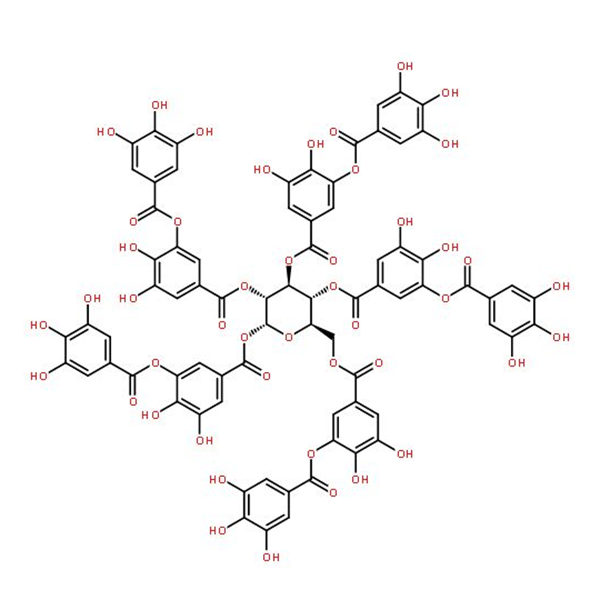
PRODUCTS CENTER
——
Pyrogallol
Product DetailsSpecification DataApplication
Other names: 1,2,3-Trihydroxybenzene
Chemical name: pyrogallic acid
Structural formula: C₆H₃(OH)₃, 126.11 g/mol
CAS: 87-66-1
Appearance: White crystalline powder
| Specifications | Industrial grade |
| Content | ≥99% |
| Loss on drying | ≤10% |
| Residue of ignition | ≤0.1% |
| APHA chromaticity | ≤ 180 times |
| Water solubility | Clarification without turbidity |
| Chloride | ≤0.02% |
| Sulfates | ≤0.02% |
| Tannin content | No turbidity |
Pyrogallol, also known as 1,2,3-trihydroxybenzene or gallic acid, is a versatile organic compound with a broad spectrum of applications in various industries due to its unique chemical properties. As a reagent and an intermediate in chemical synthesis, Pyrogallol is widely utilized in chemical analysis, pharmaceuticals, food, cosmetics, microelectronics, and other fields. This aromatic compound, which contains three hydroxyl groups attached to a benzene ring, exhibits remarkable antioxidative and reducing properties, making it invaluable in many industrial processes. In this expanded overview, we will explore its diverse applications in different sectors.
Chemical Analysis
In the realm of chemical analysis, Pyrogallol plays a crucial role as a reagent, particularly in deoxygenation processes. It is commonly used for removing oxygen from gas samples during the analysis of nitrogen fertilizers, petrochemical production, coking, smelting, and other industrial processes. This property is essential in many industries that require an oxygen-free environment or in the preparation of gases for further testing. Pyrogallol effectively absorbs oxygen, which helps to prevent oxidation and ensures the accuracy of various gas analysis methods. Its use in these processes helps improve the efficiency and reliability of chemical reactions and measurements, especially in sensitive environments.
Pharmaceutical Field
In the pharmaceutical industry, Pyrogallol is an important raw material for the synthesis of various drugs due to its bioactive properties. It serves as a precursor for the production of pharmaceuticals that treat cardiovascular and cerebrovascular diseases, as well as certain anti-tumor medications. Pyrogallol’s antioxidant and anti-inflammatory effects are particularly valuable in the formulation of drugs designed to combat oxidative stress, a key factor in the development of many chronic diseases. Additionally, it has been studied for its potential neuroprotective effects, which can help in the treatment of conditions such as Alzheimer's disease and Parkinson’s disease.
Moreover, Pyrogallol has been used in the synthesis of medications for improving circulation and reducing clot formation. Its ability to scavenge free radicals and inhibit the formation of reactive oxygen species (ROS) is particularly beneficial in the prevention of cellular damage, contributing to the efficacy of drugs targeting vascular health. As the pharmaceutical industry continues to explore new therapeutic options, Pyrogallol remains an important compound in drug development, with applications extending to various areas of medicine.
Food Industry
In the food industry, Pyrogallol is utilized as a food additive due to its acidic properties. It serves as an acidifier, particularly in products such as condiments, beverages, and canned foods. Its use as an acidulant helps regulate the pH level of food products, which is crucial for preserving flavor, texture, and safety. For example, in the production of canned fruits or beverages, Pyrogallol can be added to adjust the acidity and improve the shelf life by inhibiting microbial growth. It also enhances the preservation of color and flavor in processed foods, preventing undesirable chemical changes that may occur during storage.
Beyond its role as an acidifier, Pyrogallol has antioxidant properties that contribute to the preservation of food products. By protecting against oxidative damage, it helps maintain the nutritional quality of food, reducing the degradation of vitamins and other sensitive components. Its inclusion in food formulations ensures that products remain stable and retain their desired characteristics over time.
Cosmetic Industry
In the cosmetic industry, Pyrogallol is applied to a variety of products, particularly in the formulation of hair care and skin care products. It is commonly found in formulations for puff powders, hair conditioners, and hair dyes. Due to its antioxidant properties, Pyrogallol can help to protect hair and skin from oxidative stress, which is a major factor in aging and damage caused by environmental exposure.
As an ingredient in hair dye, Pyrogallol acts as a reducing agent, facilitating the oxidation of hair coloring agents. It helps to ensure that hair dye formulations deliver consistent and long-lasting results. Additionally, Pyrogallol is utilized in hair conditioners to improve the health and appearance of hair, preventing damage from free radicals and environmental stressors. Its inclusion in skin care products also helps protect the skin, promoting a more youthful and healthy appearance by reducing the effects of oxidative damage and environmental pollutants.
Microelectronics Industry
In the microelectronics industry, Pyrogallol is employed as a synthetic raw material for the production of photosensitive materials. These materials are used in the fabrication of various electronic components, such as photolithographic resists and other semiconductors. Pyrogallol’s unique chemical structure allows it to participate in the formation of materials that are sensitive to light, making it an essential component in the production of microelectronic devices. As the demand for more advanced microelectronics continues to grow, Pyrogallol’s role in this field is becoming increasingly important.
Its ability to facilitate chemical reactions under exposure to light makes Pyrogallol an indispensable component in the development of cutting-edge electronic technologies, including integrated circuits and display technologies. In addition, Pyrogallol’s properties help ensure that these materials maintain their effectiveness over time, providing the stability needed for high-performance electronic devices.
Other Applications
In addition to the aforementioned applications, Pyrogallol is used in a variety of other industries. In the leather industry, it serves as a dyeing agent, helping to produce various colors and finishes in leather products. Its application in the tanning process enhances the color and texture of leather, making it more appealing to consumers.
Pyrogallol is also utilized as an antioxidant and polymer blocker in the production of rubber materials. It helps prevent premature vulcanization, which can compromise the quality of rubber products. By inhibiting the crosslinking of polymer chains during the manufacturing process, Pyrogallol ensures that rubber products maintain their desired properties, such as elasticity and durability.
In electroplating, Pyrogallol is added to electroplating solutions to improve the quality of plated products. It helps reduce defects, improve adhesion, and ensure a smooth finish. This makes Pyrogallol an important component in the production of high-quality metal coatings used in various industries, including automotive, electronics, and jewelry.
Additionally, Pyrogallol is employed as an anti-scaling agent in the PVC polymerization process. It helps reduce the formation of scales on the inner walls of polymerization kettles, which can hinder the efficiency of the process. By preventing scale buildup, Pyrogallol contributes to the smooth operation of PVC production, ensuring higher-quality polymer products.
Keyword: Pyrogallol
Prev: Propyl gallate
Next: Tannic acid
Product Inquiry
Related Products
Products
-

Gallic acid
Chemical name : 3,4,5-trihydroxybenzoic acid. Molecular formula:C₇H₆O₅ CAS: 149-91-7 It can be widely found in the nature, such as Rheum Palmatum, Swamp Mahogany, dogwood, etc. Gallic acid is widely applied in multiple fields such as food, biology, pharmaceutical, chemical industry, semiconductor, etc.
-

Methyl gallate
Chemical name : 3,4,5-trihydroxybenzoate. CAS:99-24-1; Chemical formula:C₈H₈O₅. It is widely applied in multiple fields such as food, biology, pharmaceutical, chemical industry, semiconductor, etc.
-

Propyl gallate
Chemical name: 3,4,5-trihydroxybenzoate. CAS:121-79-9; Molecular formula : C₁₀H₁₂O₅. It is used as an antioxidant additive in industries like food pharmaceutical, cosmetic, hair care product, feed and semiconductor; and as a stabilizer in manufacturing of green fiber and a rubber antioxidant.
-

Pyrogallol
Pyrogallol is also called pyrogallic acid. Chemical name: 1,2,3-trihydroxy benzene. CAS:87-66-1 Molecular formula :C₆H₆O₃. It is obtained by decarboxylic reaction of gallic acid.
-

Tannic acid
Tannic acid also called tannin is an organic compound. CAS:1401-55-4 Chemical formula: C₇₆H₅₂O₄₆. Tannic acid can be used for making gallic acid.

